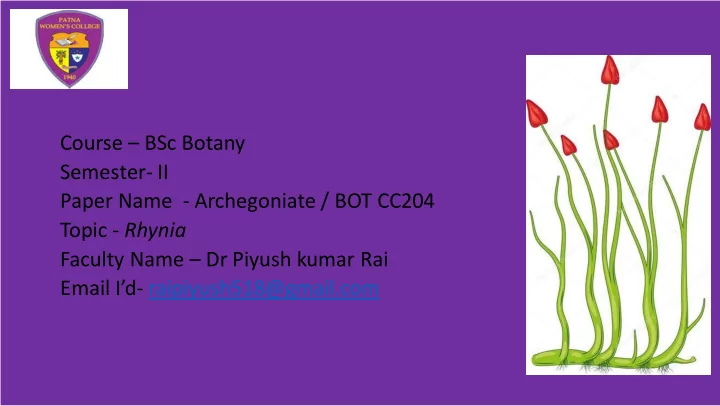

Course – BSc Botany Semester- II Paper Name - Archegoniate / BOT CC204 Topic - Rhynia Faculty Name – Dr Piyush kumar Rai Email I’d - raipiyush518@gmail.com
INTRODUCTION • The fossils of the genus Rhynia were discovered by Kindston and Lang (1917). • All 25 genera in this order are fossil. • They become extinct during the upper Devonian .
• Two important spp. Of Rhynia, viz. • Rhynia major & Rhynia gwynne- vaughani. • The plant body of Rhynia is sporophytic. • Both species are herbaceae. • The aerial branches end in tapering vegetative apices or borne- shaped terminal end .
CL CLAS ASSIFICATION • DIVISION- Pteridophyte • SUB DIVISION - Psilophyta • CLASS – Psilophylopsida • ORDER - Psilophycales • FAMILY - Rhyniaceae • GENUS - Rhynia
INTERNAL STRUCTURE • EPIDERMIS: One cell thicked with well defined cuticle . • Fusiform cell. • Stomata present in aerial part, absent in rhizome . • Unicellular rhizoids present in rhizome .
• CORTEX : It is differentiated into outer cortex and inner cortex . • STELE : A Protostele was present in the central part of the axis as well as rhizome . • The xylem was composed of tracheids . • The Phloem was represented by 4-5 layer of thin walled elongated cell with oblique end wall .
SPORANGIA
• Sporangia were oval or slightly cylindrical . • The sporangia were forked dichotomously like the stem. • All spores were homosporous. • The wall of sporangium was thick and any means of dehiscence.
• The sporangia did not have any specialized mechanisms of dehiscence . • Liberation of spores mechanism of dehiscence took place by the decay of sporangial jacket.
GAMETOPHYTE STAGE IN RHYNIA • Some palaeobotanish suggest that some specimen of Rhinia which were considered to be sporophytic axes were probably its gametophyte
• Pant (1960) regarded the small size R. gwynne- vaughan to the gametophyte part of R. major . • Marker (1961) opined that the underground creeping parts of Rhynia is the gametophyte but not the rhizome . • Puri (1961) is of opinion of the plants described is sporophyte may be gametophyte.
ROLE OF RHYNIA PLANT IN THE EVOLUTION • Prosphenopsid line • Pro- pteropsid line • Progymnospermopsid line • Psilophytaceous line
LIFE CYCLE
CONCLUSION • It is believed that R.gwynne- Vaughan is the gametophytic generation of R.major. • Primitive vascular plants & their role in evolution of higher vascular plants provides a clear remarks that Rhyniaceous plant posses so simple structure that we can say without any hesitation that they represent one of the stages in the evolution of vascular land plants.
THANK – YOU •
Recommend
More recommend